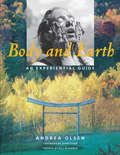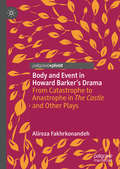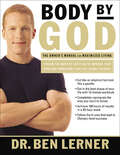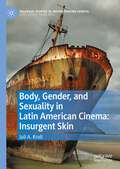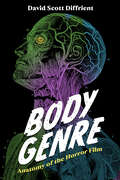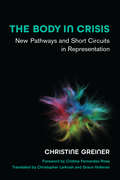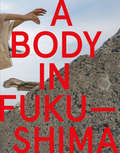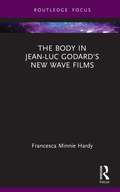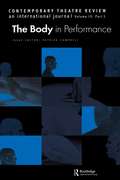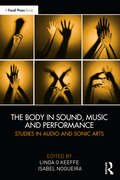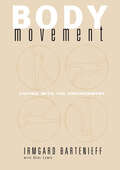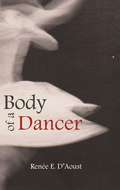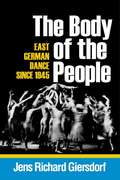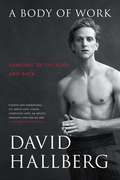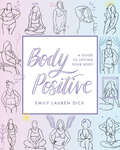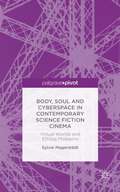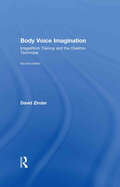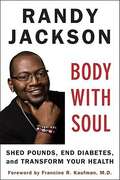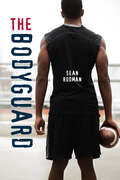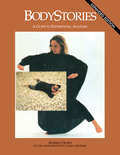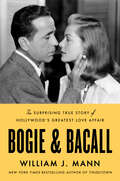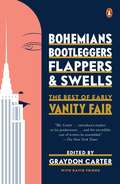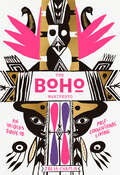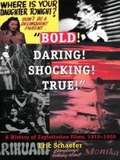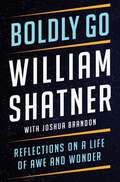- Table View
- List View
Body and Earth: An Experiential Guide (Middlebury Bicentennial Series In Environmental Studies)
by Andrea Olsen"Body is our first environment," writes Andrea Olsen. "It is the medium through which we know the earth." In a remarkable integration of environmental science, biology, meditation, and creative expression, Olsen, a dancer who teaches in the environmental studies program at Middlebury College, offers a guide to a holistic understanding of person and place. Part workbook, part exploration, Body and Earth considers the question of how we can best, most responsibly inhabit both our bodies and our planet. Olsen displays an easy command of fields as diverse as geology, biochemistry, ecology, and anatomy as she explores the ways in which our bodies are derived from and connected to the natural world. But Body and Earth is not just a lesson, it is also an investigation. Arranged as a 31-day program, the book offers not only a wealth of scientific information, but also exercises for both exploring the body and connecting with place; illustrations and works of art that illuminate each chapter's themes; and Olsen's own meditations and reflections, connecting the topics to her personal history and experience. Olsen insists that neither body nor landscape are separate from our fundamental selves, but in a culture which views the body as a mechanism to be trained and the landscape as a resource to be exploited, we need to learn to see again their fundamental wholeness and interconnection. Through hard data, reflection, exercises, and inspiration, Body and Earth offers a guide to responsible stewardship of both our planet and our persons.
Body and Event in Howard Barker's Drama: From Catastrophe to Anastrophe in The Castle and Other Plays
by Alireza FakhrkonandehThis book explores questions of gender, desire, embodiment, and language in Barker’s oeuvre. With The Castle as a focal point, the scope extends considerably beyond this play to incorporate analysis and exploration of the Theatre of Catastrophe; questions of gender, subjectivity and desire; God/religion; aesthetics of the self; autonomy-heteronomy; ethics; and the relation between political and libidinal economy, at stake in 20 other plays by Barker (including Rome, The Power of the Dog, The Bite of the Night, Judith, Possibilities, I Saw Myself, Fence in Its Thousandth Year, The Gaoler’s Ache for the Nearly Dead, The Brilliance of the Servant, Golgo, among others).
Body by God: The Owner's Manual for Maximized Living
by Ben LernerYour body is by God. God preprogrammed you to look great, have outrageous health, and experience incredible happiness. In the human body, God created a perfect design, equipped with all the organs, tissues, and cells necessary for health, production, and reproduction. The problem, asserts Dr. Ben Lerner, is when we as humans interfere with God's design for our bodies. Junk food, high-stress living, and neglecting exercise are just a few of the things we do to hinder our bodies' performance.In Body by God, Dr. Lerner offers a comprehensive plan for getting in touch with our bodies in four areas: nutrition, exercise, stress management, and time management. His "5-in-5" plan is designed to instill the good habits that will lead to optimum health benefits. Readers will learn how to get in shape with 10-minute workouts, reprogram the way they react to stress, and more. "Owner's Manual Tips" give specific ways to apply the material to real life. Our bodies are "fearfully and wonderfully made." With the help of Body by God, readers will learn how to achieve the highest level of performance from God's handiwork.
Body, Gender, and Sexuality in Latin American Cinema: Insurgent Skin (Palgrave Studies in (Re)Presenting Gender)
by Juli A. KrollInsurgent Skin: Body, Gender, and Sexuality in Latin American Cinema argues that twenty-first century Latin American cinema about lesbian, feminist, intersex, and transgender themes is revolutionary because it disrupts heteronormative and binary representation and explores new, queer signifying modes.Grounded in feminist and queer theory, Insurgent Skin conjugates film phenomenology and theories of affect and embodiment to analyze a spectrum of Latin American films.The first chapters explore queer signifying in Argentinean director Lucrecia Martel’s Salta trilogy and the lesbian utopia of Albertina Carri’s Las hijas del fuego (2018). Next, the book discusses the female body as uncanny absence in Tatiana Huezo’s documentary Tempestad (2016), a film about gendered violence in Mexico. Chapter Five focuses on intersex films and the establishing of queer solidarity and an intersex gaze. The last chapter examines transgender embodiment in the Chilean film Una mujer fantástica (2017) and Brazilian documentary Bixa Travesty (2018).
Body Genre: Anatomy of the Horror Film (Horror and Monstrosity Studies Series)
by David Scott DiffrientIn this groundbreaking work, author David Scott Diffrient explores largely understudied facets of cinematic horror, from the various odors permeating classic and contemporary films to the wetness, sliminess, and stickiness of these productions, which, he argues, practically scream out for a tactile mode of textural analysis as much as they call for more traditional forms of textual analysis. Dating back to Carol Clover’s and Linda Williams’s pioneering work on horror cinema, film scholars have long conceptualized this once-disreputable category of cultural production as a “body genre.” However, despite the growing recognition that horror serves important biological and social functions in our lives, scholars have only scratched the surface of this genre with regard to its affective, corporeal, and sensorial appeals.Diffrient anatomizes horror films in much the same way that a mad scientist might handle the body, separating and recombining constitutive parts into a new analytical whole. Further, he challenges the tendency of scholars to privilege human over nonhuman beings and calls into question ableist assumptions about the centrality to horror films of sight and sound to the near exclusion of other forms of sense experience. In addition to examining the role that animals—living or dead, real or fake—play in human-centered fictions, this volume asks what it means for audiences to consume motion pictures in which actors, stunt performers, and other creative personnel have put their own bodies and lives at risk for our amusement. Historically grounded and theoretically expansive, Body Genre: Anatomy of the Horror Film moves the study of cinematic horror into previously unchartered waters and breathes life into a subject that, not coincidentally, is intimately connected to breathing as our most cherished dividing line between life and death.
The Body in Crisis: New Pathways and Short Circuits in Representation (Studies in Dance: Theories and Practices)
by Christine GreinerThe Body in Crisis introduces the English-speaking world to the work of leading Latin American dance scholar and philosopher of the body, Christine Greiner. The book offers an innovative set of tools with which to examine the role of moving bodies and bodily actions in relation to worldwide concerns, including identity politics, alterity, migration, and belonging. The book places the concept of bodymedium in dialogue with the work of Giorgio Agamben to investigate notions of alterity, and shows how an understanding of the body-environment continuum can shed light on things left unnamed and at the margins. Greiner’s analyses draw from a broad range of theory concerned with the epistemology of the body, including cognitive science, political philosophy, evolutionary biology, and performance studies to illuminate radical experiences that question the limits of the body. Her analysis of the role that bodies play in negotiations of power relations offers an original and unprecedented contribution to the field of dance studies and expands its scope to recognize theoretical models of inquiry developed in the Global South.
A Body in Fukushima
by Eiko Otake William JohnstonOn March 11, 2011 one of the most powerful earthquakes in recorded history devastated Japan, triggering a massive tsunami and nuclear meltdowns at three reactors in the Fukushima Daiichi Nuclear Power Plant complex in a triple disaster known as 3.11. On five separate journeys, Japanese-born performer and dancer Eiko Otake and historian and photographer William Johnston visited multiple locations across Fukushima, creating 200 transformative color photographs that document the irradiated landscape, accentuated by Eiko's poses depicting both the sorrow and dignity of the land. The book also includes essays and commentary reflecting on art, disaster, and grief.From the PrefaceTHIS IS A BOOK OF FUKUSHIMA. THIS IS A BOOK OF WAILING AND UPSET, inhabiting time after March 11, 2011 and imagining time before then. This is a book of the irradiated landscape of Fukushima. This is a book of violence, and of disasters, fast and slow. This is a book of people, mountains, fields and the sea. This book is A Body in Fukushima: the body of a performer—an immigrant artist from Japan, and the body of a historian who is also a photographer, and the body of the land itself.We traveled together to Fukushima five times between 2014 and 2019. Eiko performed in the disrupted landscapes. Bill photographed the performances. Together we selected the photographs and writings for this book, and Bill wrote the captions. The year 2021 marks the tenth anniversary of the Fukushima nuclear disaster. The Timeline in the book extends to include a deeper history that is part of this tragedy and this place. And Places Visited shows the coastline where we performed and photographed. We hope that these images allow you to enter Fukushima, to feel and smell it. —EO & WJ
The Body in Jean-Luc Godard's New Wave Films (Routledge Focus on Film Studies)
by Francesca Minnie HardyThis original study examines the representation of the body in French New Wave films through discussion of a series of films by Jean-Luc Godard, perhaps the central figure of the French New Wave. Through analysis of À bout de souffle, Une femme est une femme, Le Mépris and Alphaville, alongside discussion of some of Godard’s lesser-known French New Wave films, the book explores the interrelation between bodies, books and bathrooms that they facilitate. In so doing, it aims to destabilise the French New Wave’s myth of male exceptionalism and denaturalise the gender dynamic most commonly viewed at its heart, revealing that the women who make up a fundamental part of its fabric are not textually trapped by Godard’s authorial presence. Instead, their corporeality disrupts any purported authorial and national ownership of their bodies. Given the enduring popularity and visibility of the French New Wave, and of Jean-Luc Godard, in universities and journals, The Body in Jean-Luc Godard’s New Wave Films will appeal to scholars in the disciplines of French and film studies, as well as to undergraduate and postgraduate students of these disciplines.
The Body in Performance
by Patrick CampbellLively yet intriguing, The Body in Performance is a varied collection of essays about this much-discussed area. Posing the question "Why this current preoccupation with the performed body?" the collection of specially commissioned essays from both academics and practitioners - in some cases one and the same person - considers such cutting edge topics as the abject body and performance, censorship and live art, the presentation of violence on stage, carnal art, and the vexed issue of mimesis in the theatre. Drawing variously on the work of Franko B., Orlan, Annie Sprinkle, Karen Finley, and Forced Entertainment, it concludes with a creative piece about a 'Famous New York Performance Artist.' Contributors include Rebecca Schneider whose book The Explicit Body in Performance is a key text in this area, and Joan Lipkin, director and writer.
The Body in Sound, Music and Performance: Studies in Audio and Sonic Arts
by Linda O KeeffeThe Body in Sound, Music and Performance brings together cutting-edge contributions from women working on and researching contemporary sound practice. This highly interdisciplinary book features a host of international contributors and places emphasis on developments beyond the western world, including movements growing across Latin America. Within the book, the body is situated as both the site and centre for knowledge making and creative production. Chapters explore how insightful theoretical analysis, new methods, innovative practises, and sometimes within the socio-cultural conditions of racism, sexism and classicism, the body can rise above, reshape and deconstruct understood ideas about performance practices, composition, and listening/sensing. This book will be of interest to both practitioners and researchers in the fields of sonic arts, sound design, music, acoustics and performance.
Body Movement: Coping with the Environment
by Irmgard Bartenieff Dori Lewis"'Irmgard Bartenieff has a profound knowledge of the human body and how it moves. I am delighted that this will now be made available to many more people.'." -- George Balanchine of Director, New York City Ballet"'Irmgard Bartenieff's pioneering work in the multiple applications of Labananalysis has had a transforming influence on many areas of movement training. Her careful and detailed development of the spatial principles into active corrective work has illuminated and altered the training of people as varied as dancers, choreographers, physical therapists, movement and dance therapists, and psychotherapists. Anthropologists and non-verbal communication researchers have found their world view necessarily altered by her fundamental innovations. The field of body/mind work will need to adapt to include her clear working through of basic principles.'." -- Kayla Kazahn Zalk of President, American Dance Guild
Body of a Dancer
by Renee D'Aoust"A remarkably clear-eyed descent into New York's surreal world of modern dance peopled by the obsessed, dispossessed, sexy, suicidal, brutal, broke, and absurd."-Lance Olsen, author of Nietzsche's KissesThe award-winning writer Renée E. D'Aoust draws from her experiences as a modern dancer in New York during the nineties. Her luminous prose spotlights this passionate, often brutal world. Trained at the prestigious Martha Graham Center, D'Aoust intertwines accounts of her own and other dancers' lives with essays on modern dance history. A dancer's body, scarred, strained, and tough, bears witness to the discipline demanded by the art form. Body of a Dancer provides a powerful, acidly comic record of what it is to love, and eventually leave, a life centered on dance."With exquisite description, absolute honesty, and a clear compelling voice, Body of a Dancer offers an unforgettable account of one artist's bittersweet journey."-Dinty W. MooreRenée E. D'Aoust's essays have been featured as notable essays in Best American Essays in 2006, 2007, and 2009. Her nonfiction work has been included in the anthology Reading Dance, edited by Robert Gottlieb and nominated for the Pushcart Prize. D'Aoust is the recipient of an NEA Dance Criticism fellowship and grants from The Puffin Foundation and the Idaho Commission on the Arts.
The Body of the People
by Jens Richard GiersdorfThe Body of the Peopleis the first comprehensive study of dance and choreography in East Germany. More than twenty years after the fall of the Berlin Wall, Jens Richard Giersdorf investigates a national dance history in the German Democratic Republic, from its founding as a Communist state that supplanted the Soviet zone of occupation in 1949 through the aftermath of its collapse forty years later, examining complex themes of nationhood, ideology, resistance, and diaspora through an innovative mix of archival research, critical theory, personal narrative, and performance analysis. Giersdorf looks closely at uniquely East German dance forms-including mass exercise events, national folk dances, Marxist-Leninist visions staged by the dance ensemble of the armed forces, the vast amateur dance culture, East Germany’s version of Tanztheater, and socialist alternatives to rock ‘n roll-to demonstrate how dance was used both as a form of corporeal utopia and of embodied socialist propaganda and indoctrination. The Body of the Peoplealso explores the artists working in the shadow of official culture who used dance and movement to critique and resist state power, notably Charlotte von Mahlsdorf, Arila Siegert, and Fine Kwiatkowski. Giersdorf considers a myriad of embodied responses to the Communist state even after reunification, analyzing the embodiment of the fall of the Berlin Wall in the works of Jo Fabian and Sasha Waltz, and the diasporic traces of East German culture abroad, exemplified by the Chilean choreographer Patricio Bunster.
A Body of Work: Dancing to the Edge and Back
by David HallbergDavid Hallberg, the first American to join the famed Bolshoi Ballet as a principal dancer and the dazzling artist The New Yorker described as &“the most exciting male dancer in the western world,&” presents a look at his artistic life—up to the moment he returns to the stage after a devastating injury that almost cost him his career.Beginning with his real-life Billy Elliot childhood—an all-American story marred by intense bullying—and culminating in his hard-won comeback, Hallberg&’s &“moving and intelligent&” (Daniel Mendelsohn) memoir dives deep into life as an artist as he wrestles with ego, pushes the limits of his body, and searches for ecstatic perfection and fulfillment as one of the world&’s most acclaimed ballet dancers.Rich in detail ballet fans will adore, Hallberg presents an &“unsparing…inside look&” (The New York Times) and also reflects on universal and relatable themes like inspiration, self-doubt, and perfectionism as he takes you into daily classes, rigorous rehearsals, and triumphant performances, searching for new interpretations of ballet&’s greatest roles. He reveals the loneliness he felt as a teenager leaving America to join the Paris Opera Ballet School, the ambition he had to tame as a new member of American Ballet Theatre, and the reasons behind his headline-grabbing decision to be the first American to join the top rank of Bolshoi Ballet, tendered by the Artistic Director who would later be the victim of a vicious acid attack. Then, as Hallberg performed throughout the world at the peak of his abilities, he suffered a crippling ankle injury and botched surgery leading to an agonizing retreat from ballet and an honest reexamination of his entire life.Combining his powers of observation and memory with emotional honesty and artistic insight, Hallberg has written a great ballet memoir and an intimate portrait of an artist in all his vulnerability, passion, and wisdom. &“Candid and engrossing&” (The Washington Post), A Body of Work is a memoir &“for everyone with a heart&” (DC Metro Theater Arts).
Body Positive: A Guide to Loving Your Body
by Emily Lauren DickPacked with introspective questions and gorgeous, un-retouched photographs that display the bodies of real, everyday women aimed at teaching young women that every body is beautiful and happiness comes in all shapes and sizes. A Foreword Reviews recommended title for Mental Health Awareness Month
Body, Soul and Cyberspace in Contemporary Science Fiction Cinema: Virtual Worlds and Ethical Problems
by Sylvie MagerstädtBody, Soul and Cyberspace explores how recent science-fiction cinema addresses questions about the connections between body and soul, virtuality, and the ways in which we engage with spirituality in the digital age. <P><P> The book investigates notions of love, life and death, taking an interdisciplinary approach by combining cinematic themes with religious, philosophical and ethical ideas. Magerstadt argues how even the most spectacle-driven mainstream films such as Avatar, The Matrix and Terminator can raise interesting and important questions about the human self and our interaction with the world. <P><P>Apart from these well-known science fiction epics, her analysis also draws on recent works, such as Inception, The Thirteenth Floor, eXistenZ, Aeon Flux, Total Recall (2012), Transcendence and TRON: Legacy. These films stimulate an engaging discussion on what makes us human, the role memory plays in understanding ourselves, and how virtual realities challenge the moral concepts that govern human relationships.
Body Voice Imagination: ImageWork Training and the Chekhov Technique (A\theatre Arts Book Ser.)
by David ZinderFirst published in 2008. Routledge is an imprint of Taylor & Francis, an informa company.
Body with Soul
by Randy JacksonFrom beloved American Idol judge a complete, inspiring wellness plan for taking control of your health The obesity epidemic is spreading throughout America, bringing with it health problems from diabetes to hypertension to heart disease. A lifetime of poor fitness and nutrition choices left Randy Jackson lethargic, overweight, and with a diagnosis of Type II diabetes. After years of yo-yo diets, hours in the gym, and even gastric bypass surgery, Randy finally decided to change his life. Body with Soul is his tried-and-true wellness plan; filled with meal plans, re-tooled recipes of Southern favorites, and workouts for people on the go, the regimen here is user-friendly and promises results. Having lost one hundred pounds, Randy is healthier than ever, and his diabetes has been in remission for five years. The program offered by Body with Soul ensures that readers, like Randy, can get their health in check, and lead happier, healthier lives. .
The Bodyguard (Orca Soundings)
by Sean RodmanRyan wants to give up football and apply to his dream university, but to afford it he may have to insert himself into some strange and possibly dangerous situations. Ryan Hale, aka Replay, is the most successful running back in his high school's history. With university scouts making him offers he can't refuse, his future seems set. The problem is, Ryan would much rather go to film school. But his dad doesn't want to hear it. His teammates sure don't. He can't afford the application fees anyway. But then a solution appears when Markus, a strange exchange student with outrageous stories about mobsters and hackers, offers to pay Ryan to be his bodyguard. Things get complicated when Ryan realizes the stories may be closer to the truth than anyone imagined. This short novel is a high-interest, low-reading level book for teen readers who are building reading skills, want a quick read or say they don’t like to read! The epub edition of this title is fully accessible.
BodyStories: A Guide to Experiential Anatomy
by Andrea OlsenBodyStories is a book that engages the general reader as well as the serious student of anatomy. Thirty-one days of learning sessions heighten awareness about each bone and body system and provide self-guided studies. The book draws on Ms. Olsen's thirty years as a dancer and teacher of anatomy to show how our attitudes and approaches to our body affect us day to day. Amusing and insightful personal stories enliven the text and provide ways of working with the body for efficiency and for healing. BodyStories is used as a primary text in college dance departments, massage schools, and yoga training programs internationally.
Bogie & Bacall: The Surprising True Story of Hollywood's Greatest Love Affair
by William J. MannFrom the noted Hollywood biographer and author of The Contender comes this celebration of the great American love story—the romance between Lauren Bacall and Humphrey Bogart—capturing its complexity, contradictions, and challenges as never before.In Bogie & Bacall, William Mann offers a deep and comprehensive look at Lauren Bacall, Humphrey Bogart, and the unlikely love they shared. Mann details their early years—Bogart’s effete upbringing in New York City; Bacall’s rise as a model and actress. He paints a vivid portrait of their courtship and twelve-year marriage: the fights, the reconciliations, the children, the affairs, Bogie’s illness and Bacall’s steadfastness until his death. He offers a sympathetic yet clear-eyed portrait of Bacall’s life after Bogie, exploring her relationships with Frank Sinatra and Jason Robards, who would become her second husband, and the identity crisis she faced.Surpassing previous biographies, Mann digs deep into the celebrities’ personal lives and considers their relationship from surprising angles. Bacall was just nineteen when she started dating the thrice-married forty-five-year-old Bogart. How might that age gap have influenced their relationship? In addition to what she gained, what might Bacall have lost by marrying a Hollywood superstar more than twice her age? How did Bogart, a man of average looks, become one of the greatest movie stars of all time? Throughout, Mann explains the unparalleled successes of their individual careers as well as the extraordinary love between them and the legend that has endured.Filled with entertaining details and thoughtful insights based on newly available records and correspondence, and illustrated with 30-40 photographs, Bogie & Bacall offers a fresh look at this famous couple, their remarkable relationship, and their legacy.
Bohemians, Bootleggers, Flappers, and Swellss: The Best of Early Vanity Fair
by David Friend Graydon CarterOffering readers an inebriating swig from the great cocktail shaker of the Roaring Twenties--the Jazz Age, the age of Gatsby--Bohemians, Bootleggers, Flappers, and Swells showcases unforgettable writers in search of how to live well in a changing era. Vanity Fair editor Graydon Carter introduces these fabulous pieces written between 1913 and 1936, when the magazine published a Murderers' Row of the world's leading literary lights, including:F. Scott Fitzgerald on what a magazine should beClarence Darrow on equalitye. e. cummings on Calvin CoolidgeD. H. Lawrence on womenDjuna Barnes on James JoyceJohn Maynard Keynes on the collapse in money valueDorothy Parker on a host of topics, from why she hates actresses to why she hasn't marriedpo Marx, Carl Sandburg on Charlie Chaplin, Djuna Barnes on James Joyce, Douglas Fairbanks, Jr., on Joan Crawford, and Dorothy Parker on a host of topics ranging from why she hates actresses to why she hasn't married. These essays reflect the rich period of their creation while simultaneously addressing topics that would be recognizable in the magazine today, such as how women should navigate work and home life; our destructive fascination with the entertainment industry and with professional sports; the collapse of public faith in the financial industry; and, as Aldous Huxley asks herein, "What, Exactly, Is Modern?" Offering readers an inebriating swig from that great cocktail shaker of the Roaring Twenties, the Jazz Age, the age of Gatsby, Bohemians, Bootleggers, Flappers, and Swells showcases unforgettable writers in search of how to live well in a changing era.
The Boho Manifesto: An Insider's Guide to Postconventional Living
by Julia ChaplinThe bohemian disruption has arrived. Microdosing psychedelics has become the new business learning tool, spiritual ceremonies and ideas festivals are now coveted pastimes, and Burning Man is already a bigger cultural touchstone than Woodstock. Written by boho-from-birth Julia Chaplin, The Boho Manifesto is here to illuminate the revolution. This finely detailed and richly illustrated handbook is the essential guide to what lies beyond the experience of everyday conformity. You’ll learn how to quit the gym and go dancing instead and how to become a sex-positive tantric unicorn. And, should you be ready, there’s advice on how to leave your cubicle behind and embrace the life of a nomadic entrepreneur—or at least a nomad.
“Bold! Daring! Shocking! True!”: A History of Exploitation Films, 1919-1959
by Eric SchaeferUnashamed nudists, high-flying hopheads, brazen strippers, vicious vice lords, and high school girls who find themselves "in trouble" comprise the population of exploitation films. In the first full-scale history of these low-budget movies of decades past, Eric Schaefer reveals how this pioneering form of "trash film" purveyed the forbidden thrills of explicit sexual behavior, drug use, and vice that the mainstream movie industry could not show. Bold! Daring! Shocking! True! is a meticulously researched, interdisciplinary study that is informed by a wide range of sources--including both mainstream and industry newspapers and periodicals, archival accounts, personal interviews, and the films themselves. Schaefer begins by exploring the unique mode of production of exploitation movies, their distribution, and the outrageous exhibition practices that were rooted in the traditions of sideshows and carnivals. His close analysis of dozens of films, such as The Road to Ruin, Modern Motherhood, One Way Ticket to Hell, and The Wages of Sin demonstrates that these films were more than simply "bad" movies. By situating exploitation films in a historical context and organizing them according to the social problems they addressed, Schaefer shows how they evolved during a period of forty years and how, during that time, they shaped public policies and attitudes. Finally, he focuses on the changes in the postwar American film industry that led to the decline of the classical exploitation film and set the stage for the rise of "sexploitation" in the 1960s. Engagingly written, illustrated with rare photographs, posters, production stills, and ad slicks, and offering a full filmography, Bold! Daring! Shocking! True! reveals a forgotten side of film history and American culture. It will delight and inform those interested in film history, cultural studies, American studies and history, and the many fans of exploitation films.
Boldly Go: Reflections on a Life of Awe and Wonder
by William ShatnerThe beloved star of Star Trek, recent space traveler, and living legend William Shatner reflects on the interconnectivity of all things, our fragile bond with nature, and the joy that comes from exploration in this inspiring, revelatory, and exhilarating collection of essays.Long before Gene Roddenberry put him on a starship to explore the galaxy, long before he actually did venture to space, William Shatner was gripped by his own quest for knowledge and meaning. Though his eventful life has been nothing short of extraordinary, Shatner is still never so thrilled as when he experiences something that inspires him to simply say, &“Wow.&” Within these affecting, entertaining, and informative essays, he demonstrates that astonishing possibilities and true wonder are all around us. By revealing stories of his life—some delightful, others tragic—Shatner reflects on what he has learned along the way to his ninth decade and how important it is to apply the joy of exploration to our own lives. Insightful, irreverent, and with his signature wit and dramatic flair, Boldly Go is an unputdownable celebration of all that our miraculous universe holds for us.
